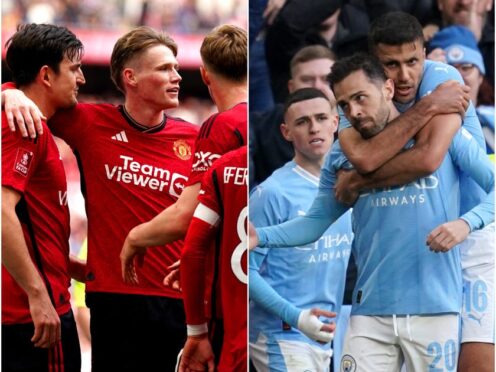
Manchester City and Manchester United will meet in the FA Cup final for the second year in a row after City beat Chelsea and United survived a thrilling semi-final against Coventry.
Here, the PA news agency looks at their head-to-head record in the competition and the historical significance of next month’s clash.
Previous meetings

Ilkay Gundogan’s goal after 12 seconds – the fastest FA Cup final goal in history – is the abiding memory of City’s 2-1 win last year.
Bruno Fernandes equalised from a penalty but a second Gundogan strike sealed City’s fourth and most significant victory in nine FA Cup derbies dating back almost a century.
City won the 1926 semi-final 3-0, Tommy Browell scoring twice, but went on to lose the final 1-0 to Bolton. The Manchester rivals did not meet in the competition again until a 1955 fourth-round clash also won by City, 2-0.
United won the next four ties against City, starting with another fourth-round meeting in 1970 when Brian Kidd – a future assistant manager of both clubs – scored twice in a 3-0 win.
Norman Whiteside scored the only goal in 1987’s third-round tie and Eric Cantona’s penalty proved decisive in a 2-1 fifth-round win in 1996. They met at that stage again in 2004, Ruud van Nistelrooy scoring twice as United won 4-2 despite Gary Neville’s first-half dismissal.
A solitary Yaya Toure goal settled the 2011 semi-final in City’s favour before United’s Paul Scholes was sent off – this time City went on to win the competition, beating Stoke in the final.
United held off a second-half fightback from 10-man City in the following season’s third round, Wayne Rooney’s brace setting up a 3-2 win, before Gundogan’s Wembley heroics last year.
Deja vu

This will be the first time in 129 years that the same two clubs have met in the final in consecutive seasons. Queen’s Park, the only Scottish side to play in an FA Cup final, were beaten by Blackburn in both 1884 and 1885 at the Oval.
The nearest in the intervening years has been the same two teams meeting three years apart, most recently Arsenal beating Chelsea 2-1 in both 2017 and 2020. City and United will become the 17th pair of teams to meet in multiple finals.
United rank second all time for FA Cup wins, two behind Arsenal on 12, and will remain there regardless of the outcome this time around. Victory for City would be their eighth, lifting them to joint third alongside Chelsea, Liverpool and Tottenham.

Enjoy the convenience of having The Sunday Post delivered as a digital ePaper straight to your smartphone, tablet or computer.
Subscribe for only £5.49 a month and enjoy all the benefits of the printed paper as a digital replica.
Subscribe